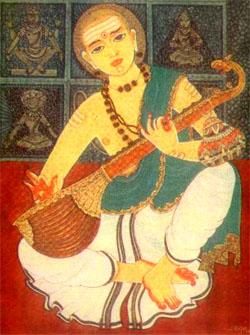Special Features
THE DIKSHITAR SISHYA PARAMPARA
Dikshitar’s sishya parampara is primarily represented by his direct descendants. Muthuswami Dikshitar’s brother, Baluswami Dikshitar is followed by Subbarama Dikshitar, Ambi Dikshitar, and Baluswami Dikshitar (great-grandson of Dikshitar). The liberal attitude discovered in the Tyagaraja parampara was not prevalent in the Dikshitar school, which tended to be more conservative and secretive. The release of Muthuswami Dikshitar ‘s compositions to the masses, synchronized with Ambi Dikshitar’s migration from Ettayapuram to Chennai. It is only during Ambi Dikshitar’s sojourn at Chennai that veterans like Kallidaikurichi Vedanta Bhagavatar, Anantakrishna Iyer, Sundaram Iyer and Kallidaikurichi Mahadeva Iyer came under his aegis. This heralded the advent of a liberal, strong and fruitful movement. Ananthakrishna Iyer, Sundaram Iyer and Mahadeva Iyer transcribed several compositions of Muthuswami Dikshitar from the palm-leaf manuscripts treasured by the family. Sundaram Iyer published several volumes containing Dikshitar’s compositions, with the support and guidance of the Sanskrit scholar, Dr. V Raghavan.

However, Panchanada Iyer’s association with Muthuswamy Dikshitar, was more likely at Tanjavur, then at Tirvarur. Tanjavur will forever be remembered for the quartet - Ponniah, Chinniah, Vadivelu and Sivanandam. Ponniah’s compositions like ‘Mayateeta swaroopini’ and ‘Satileni’ refer to Muthuswami Dikshitar as their guru and of their having been blessed by him. Manuscripts are said to be in possession of this family. We implore Sangeeta Kalanidhi Sivanandam and guru Kittappa, to bring to light, unheard of kritis composed by Muthuswami Dikhitar.
The dissemination of Dikshitar’s compositions, has for its epicenter, Ettayapuram. Disciples did gather at Ettayapuram, in the last days of Muthuswami Dikshitar. Yet, there is not adequate proof of propagation in Baluswami Dikshitar’s days. Credit, perhaps, should go to Subbarama Dikshitar. At the turn of the 20th century, Dikshitar’s kritis spread in south Tamilnadu. Semmangidu Srinivasa Iyer, observed at a seminar that the repertoire of Dikshitar kritis available at the Chola region was limited. The Tirunelveli region produced many disciples – Kalakkadu Subramanya Bhagavatar, Pallakurichi Subbiah Bhagavatar and Srivilliputtur Muthaiah Bhagavatar, amongst them. Kodaganallur Subbiah Bhagavatar was a later personage. However, the treasure trove of kritis was in the care of Kallidaikurichi Vedanta Bhagavatar and Ramalinga Bhagavatar, who popularized Dikshitar kritis through Lalitopakhyana. These vidwans imbibed knowledge from Ambi Dikshitar. Vedanta Bhagavatar’s disciples included Mahadeva Iyer and Pattamadai Sundaram.
Sangeeta Kalanidhi Justice T L Venkatarama Iyer took pioneering efforts to learn and teach Dikshitar’s kritis. He interacted closely with Ambi Dikshitar and Vedanta Bhagavatar. Venkatarama Iyer’s association with Dr. V Raghavan was a boost to this movement. If Venkatarama Iyer heralded the renaissance, Dr. Raghavan symbolized high-noon. Dr. Raghavan was instrumental in the publication of the Sangeeta Sampradaya Pradarsini and also for the periodic publication of Dikshitar’s kritis in the journal of the Music Academy by Sundaram Iyer. Venkatarama Iyer taught several disciples, prominent among them being Sangeeta Kalanidhis D K Pattammal and B Rajam Iyer. His disciples include Sandhyavandanam Srinivasa Rao, Vidya Shankar and B Krishnamurthy. Mention has to be made of the fact that Ambi Dikshitar himself has taught D K Pattammal a few Dikshitar kritis.
Maha Vaidyanatha Iyer was introduced to Dikshitar kritis by his disciple Vasudevanallur Subbiah Bhagavatar. Vaidyanatha Iyer popularized kritis like ‘Vatapi Ganapatim’, ‘Tyagaraja namaste’ and ‘Chintaya Makanda’. Konerirajapuram Vaidyanatha Iyer gave masterly expositions of ‘Balagopala’ and ‘Sri Subramanyaya Namaste’. Rajam Iyer’s associations with Ariyakkudi and Madurai Mani Iyer brought out the Navagraha kritis and compositions like 'Seshachala Nayakam' and 'Sarasijanabha sodari'. Alathur Venkatesa Iyer became an ardent devotee of Dikshitar, though he was basically Tyagarajophile.
D K Pattammal is known for her perfect diction and lucid rendition of Dikshitar’s kritis. Sangeeta Kalanidhi G N Balasubramanyam’s name is associated with kritis like ‘Sivakameswareem’, ‘Karikalabha mukham’ and ‘Varadarajam upasmahe’. This tradition is currently in the hands of vidwans like Vedavalli (a disciple of Mahadeva Iyer), N. Ramanathan, Kalavathi Balakrishnan, V Ramachandran and a few others. The next generations should now emerge.
Dr. V V Srivatsa